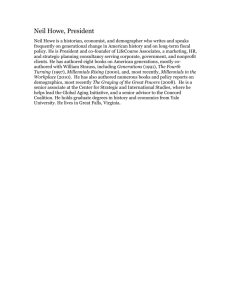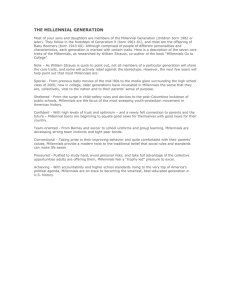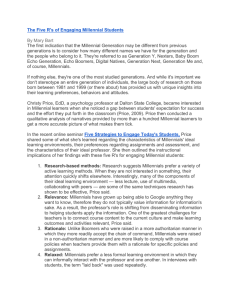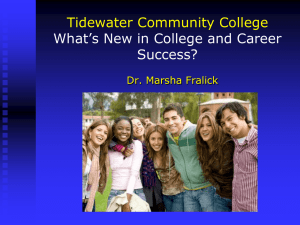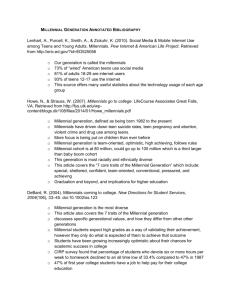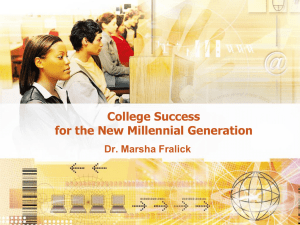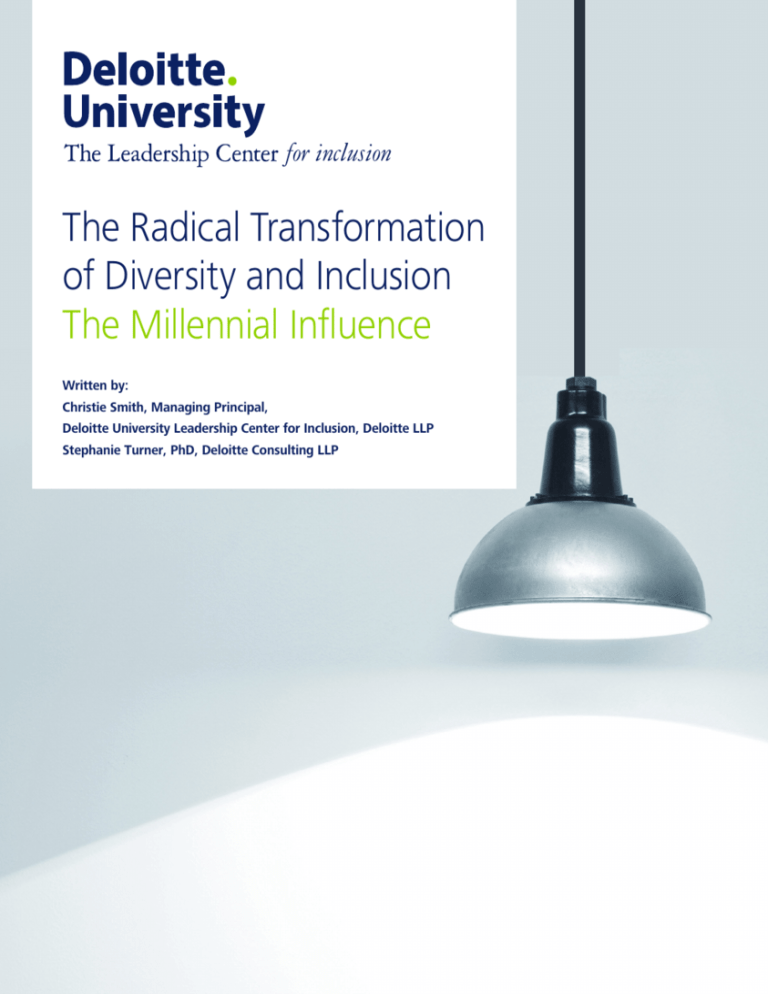
for inclusion
The Radical Transformation
of Diversity and Inclusion
The Millennial Influence
Written by:
Christie Smith, Managing Principal,
Deloitte University Leadership Center for Inclusion, Deloitte LLP
Stephanie Turner, PhD, Deloitte Consulting LLP
for inclusion
As a result of our shared commitment to moving the needle on inclusion in global business environments, the Billie Jean
King Leadership Initiative (BJKLI) and Deloitte have joined forces to identify the issues impacting today’s diverse workforce.
The Radical Transformation of Diversity and Inclusion: The Millennial Influence is the first research report to come from
our ground-breaking collaboration.
In this study, we examine generational views of diversity and inclusion and their impact on innovation, engagement, and
creativity and other business outcomes. What we have uncovered could change the way organizations approach inclusion
across corporate America for years to come.
At the heart of this work is a generational gap that suggests that millennials view inclusion as having a culture of
connectedness that facilitates teaming, collaboration, and professional growth. This is in stark contrast to prior generations
who traditionally consider it from the perspectives of representation and assimilation. A few of our key findings include:
• When defining diversity, millennials are 35 percent more likely to focus on unique experiences, whereas 21 percent
of non-millennials are more likely to focus on representation.
• When asked about the business impact of diversity, millennials are 71 percent more likely to focus on teamwork
compared with 28 percent of non-millennials who are more likely to focus on fairness of opportunity.
• 83 percent of millennials are actively engaged when they believe their organization fosters an inclusive culture, compared
to only 60 percent of millennials who are actively engaged when their organization does not foster an inclusive culture.
• Millennials believe that programs aimed at diversity and inclusion should focus on improved business opportunities
and outcomes as a result of the acceptance of cognitive diversity, specifically individualism, collaboration, teamwork,
and innovation.
With millennials, the most traditionally diverse, digitally connected, and socially minded group of professionals, set to
comprise nearly 75 percent of the workforce by 2025, we believe this research is critical to informing and elevating
the inclusion conversations taking place across corporate America. These findings provide an incredible opportunity
for organizations to play an important role in breaking down barriers and getting to solutions that promote teamwork,
collaboration, and enhanced business performance.
As strong believers in the strength of inclusive and authentic workplaces, we hope this study helps to broaden your
view on the future of inclusion in your organization and the great things diverse teams can accomplish.
Billie Jean King
Founder
Billie Jean King Leadership
Initiative
M. Christine Smith, PhD
Managing Principal – Deloitte University
Leadership Center for Inclusion
Deloitte LLP
The Radical Transformation of Diversity and Inclusion The Millennial Influence
3
Contents
Millennials radically transform traditional concepts of diversity and inclusion 5
Generational perspectives on diversity and inclusion 7
Impact on the employee experience12
Fostering a cognitively diverse culture16
Conclusion19
Meet the authors 20
Additional information21
Endnotes22
Millennials radically transform traditional
concepts of diversity and inclusion
Exploring evolving definitions of
diversity and inclusion, our 2015 survey
found that the millennials are unique in
viewing cognitive diversity as essential
for an inclusive culture that supports
engagement, empowerment, and
authenticity. They also value inclusion
not as an abstract ideal that checks a
box and makes everyone feel good, but
as a critical tool that enables business
competitiveness and growth. As the
millennials flood leadership ranks,
their perspectives will demand a shift
in traditional diversity and inclusion
models. But where should we begin?
Last year, we corresponded over email with
a 29-year-old manager at a Fortune 100
consumer goods company. After hearing
about the way he structured his team, we
were interested in seeing him interact with
his employees during a weekly brainstorming
meeting. “That’s fine,” he said. “But be
prepared, when you come on site to observe
us I’m not going to introduce myself as the
manager because all points of view on this
team carry the same weight. People have the
freedom to express themselves whether they
have 30 minutes or 30 years of experience.”
As the millennial generation (also known as
Generation Y, born 1980-95) floods leadership
ranks, stories like this are not uncommon.
Millennials strive to be inclusive, but not
in the way we are accustomed to thinking
about inclusion. Decades of research and
programming have focused on assimilating
individuals of different genders, races,
ethnicities, religions, and sexual orientations
in our organizations, and the baby boomers
and Generation X-ers should be given credit
from getting us from Point A to Point B in the
inclusion discussion. Millennials, however, are
ready for Point C.
These young professionals are the most
traditionally diverse generation in history. Only
59 percent of millennials are Caucasian and
27 percent have immigrant backgrounds.1 For
them, walking into an office lobby and seeing
all types of people is a given. They are much
more concerned with cognitive diversity, or
diversity of thoughts, ideas, and philosophies,
and in solving business problems through
a culture of collaboration. For millennials,
inclusion isn’t just about getting people
of different creeds in a room. It’s about
connecting these individuals, forming teams
on which everyone has a say, and capitalizing
on a variety of perspectives in order to make a
stronger business impact.
While cognitive diversity isn’t necessarily a
new concept, it’s still not a reality in most
organizations. Companies may pay it lip
service, but much of the time, hierarchical
leadership and bureaucratic paths of
communication prevent a mixture of ideas
and approaches from taking hold.
The Radical Transformation of Diversity and Inclusion The Millennial Influence
5
We know from prior research that millennials
are more tolerant and encouraging of alternative
perspectives than older generations,2 but as
of 2015, no study had examined the degree
to which millennials hold these non traditional
beliefs about diversity and inclusion, and
the impact of changing definitions on our
organizations. Deloitte and the Billie Jean King
Leadership Initiative set out to close the gap by
surveying 3,726 global professionals of all levels,
ages, genders, races, ethnicities, and sexual
orientations. We learned that our hypothesis
was correct: while millennials value the ideals of
diversity and inclusion just like their generational
counterparts, they fundamentally define the
constructs differently, and therefore, have
different expectations relating to engagement,
empowerment, and authenticity at work.
The disconnect between the traditional
definitions of diversity and inclusion and
the millennial definitions is already causing
business hardship. By 2025, millennials will
comprise nearly 75 percent of the workforce,
and yet they change jobs approximately every
two years.3 As we learned from this research,
this is partially because they are intolerant
of workplaces that don’t allow them to be
themselves.4 Due to their desire for free
expression, 71 percent do not always follow
their organization’s social media policies,5
resulting in clashes with managers and human
resources representatives and their corporate
communications colleagues.
As used in this document, “Deloitte” means Deloitte & Touche LLP and Deloitte Financial Advisory Services
LLP, which are separate subsidiaries of Deloitte LLP. Please see www.deloitte.com/us/about for a detailed
description of the legal structure of Deloitte LLP and its subsidiaries. Certain services may not be available
to attest clients under the rules and regulations of public accounting.
6
Some organizations may be tempted to ignore
the issue and hope that millennials will eventually
grow up and out of their desire for cognitive
diversity and its resulting consequence for
inclusion initiatives, but their futures depend on
addressing it now. Businesses that don’t expand
their notions of diversity and inclusion will
increasingly lose their millennials and certainly
won’t retain Generation Z (today’s young people,
born 1996-2012), who are even less focused on
traditional diversity than their older brothers and
sisters, and are even more engaged in socially
collaborative platforms. And, the transformation
of the diversity and inclusion model isn’t just a
retention issue. The millennial viewpoint is simply
better for business. According to a recent IBM
study, 75 percent of CEOs and executive-level
leaders believe that leveraging cognitive diversity
is essential to organizational success.6
It is within the power of the current baby
boomer and Gen X majority to challenge their
traditional approaches, suspend judgment,
and break down the barriers that have been
put up around diversity and inclusion. Through
a combination of advocacy, learning, and
leadership, organizations can capitalize on the
creativity and innovation of millennial thinking
to transform business for the better.
This paper will share our findings on the
evolution of the diversity and inclusion concepts,
from what older generations conceived decades
ago and still hold to be true, to what millennials
believe today. We’ll explore the impact of
differing definitions on the employee experience
and suggest how organizations can take the
first step to infuse their operations with true
cognitive diversity.
Generational perspectives
on diversity and inclusion
In order to measure the understanding
of diversity and inclusion across the
multigenerational workforce, Deloitte/BJKLI
distributed a 62-item survey, which spanned
seven different sectors and resulted in 3,726
responses. The respondents included a mix
of ages, genders, races/ethnicities, and
orientations. They also represented various
levels of seniority within their organizations.
Approximately 26 percent of respondents
were millennials, 47 percent were Generation
X-ers (born 1964-79), and 27 percent were
baby boomers (born 1946-63). Our hypothesis
is that there exist vast differences in how
millennials view the concepts and practice
of diversity and inclusion, and that this
difference in point of view will have significant
implications to existing diversity and inclusion
programs and initiatives as a result.
“Diversity” and “inclusion” have long been
common terms in corporate cultures across
the globe—but when we really dive deep
into what each of these terms mean to each
generation, there are some striking contrasts.
Our research found that in defining diversity,
millennials move well beyond the integration
of demographic differences. They more
commonly cite diversity as the blending of
unique perspectives within a team, known as
cognitive diversity. The millennial definition
of diversity also encompasses the ability to
combine different ideas and approaches to
better overcome challenges and achieve business
goals. Overwhelmingly, millennial definitions
of diversity have a tone of possibility – with
differences in background, experiences, and
style, a team is more likely to create innovative
and groundbreaking products and services.
In other words, millennials frame diversity as a
means to a business outcome, which is in stark
contrast to older generations that view diversity
through the lens of morality (the right thing
to do), compliance, and equality. Respondents
in the Generation X and baby boomer
generations most commonly define diversity as
representation of and fairness to all individuals
and their various identifiers of gender, race,
religion, ethnicity, and sexual orientation. While
older generations aim to ensure that the mix of
people on a team accounts for all of the above
identifiers, millennials look past these identifiers
to focus on the knowledge, experience, and
unique insights individuals bring forth.
“Diversity means to me your
background based on your previous
work experience, where you were
born and raised, and any unique
factors that contribute to your
personality and behavior.”
Millennial survey respondent
The Radical Transformation of Diversity and Inclusion The Millennial Influence
7
Millennial definitions of diversity distinguish them from other generations
Our millennial respondents differed from respondents
in older generations with respect to how they defined
diversity. Our thematic analysis on participants’ qualitative
responses illustrated that millennials are more likely to
define diversity as pertaining to the individual mix of
unique experiences, identities, ideas, and opinions. Older
participants, on the other hand, frame diversity in terms of
demographics, equal opportunity, and representation of
identifiable demographic characteristics.
32%
21%
More Likely
to Focus on
RESPECTING
IDENTITIES
More Likely
to Focus on
REPRESENTATION
19%
35%
More Likely
to Focus on
RELIGION &
DEMOGRAPHICS
More Likely
to Focus on
UNIQUE
EXPERIENCES
29%
25%
More Likely to
Focus on
IDEAS, OPINIONS, &
THOUGHTS
More Likely
to Focus on
EQUALITY
Millennial
Nonmillennial
“Diversity is a variety of cultures and
perspectives working together to
solve business problems.”
Millennial survey respondent
8
Examining the concept of inclusion, we
again found significant differences between
millennial and older generation points of
view. Millennials define inclusion as having
a culture of connectedness that facilitates
teaming, collaboration, and professional
growth, and positively affects major business
outcomes. Leadership is supportive of individual
perspectives and is transparent, communicative,
and engaging.
Authors Erica Dhawan and Saj-Nicole Joni
recently coined the term “connectional
intelligence” to describe the combination
of cognitively diverse people, disciplines,
and networks to create value, meaning, and
breakthrough results.7 This approach is natural
for millennials, who are the generational
byproducts of the digital, social, and mobile
age. More so than other generations, millennials
are comfortable connecting across people and
platforms to develop new relationships, gain
access to resources, and acquire necessary
knowledge in service of their goals. They’re
the teaming generation interested in using
collaboration and integration of cognitive
diversity as a tool to drive innovation and
business impact.
Conversely, older generations define
inclusion as the acceptance and tolerance
of demographically diverse individuals. For
Generation X-ers and baby boomers, inclusion
is the process through which organizations
ensure that individuals of all genders, races,
ethnicities, religions, and sexual orientations are
protected, treated fairly, and provided consistent
opportunities free from discrimination and
prejudice. Inclusion as it relates to demographic
equality (the nonmillennial viewpoint) is a
moral and legal issue that is necessary whether
it directly benefits the business or not. On
the other hand, inclusion as it relates to the
acceptance and encouragement of cognitive
diversity (the millennial viewpoint) is a tool that
enables productivity and bottom-line results.
The Radical Transformation of Diversity and Inclusion The Millennial Influence
9
“Inclusion is having an impact at all
levels… and having open lines of
communication, transparency, and
strategic initiatives communicated
to employees by executives.”
“Diversity in the workplace
is a representative
distribution of people
across race, religion,
gender, and personal
orientation.”
“Inclusion is when
you’re a part of
the process, your
opinion counts,
and we’re working
together to a
common goal. It’s
being accountable
for decisions that
you are part of.”
“Inclusion is when
everyone in the
organization is given
equal opportunity
to work and grow
without any bias
towards religion,
race, and gender.”
“Inclusion is the work
place… the place
where people come
together to accomplish
one goal… where
business relationships
are formed because
of daily interaction
among staff
members.”
Millennial
10
“Offering roles and
opportunities to all qualified
candidates regardless of
race, creed, gender, sexual
orientation, age, or religious
affiliation.”
Nonmillennial
Millennial definitions of inclusion distinguish them from other generations
Our thematic analysis on participants’ qualitative
responses showed that when it comes to
defining inclusion, millennials focus primarily
and extensively on teaming, valuing a culture
of connectivity, and using collaborative tools to
drive business impact. Older generations instead
defined inclusion in terms of equity, fairness,
and the integration, acceptance and tolerance
of gender, racial and ethnic diversity within the
organization.
28%
More Likely
to Focus on
FAIRNESS OF
OPPORTUNITY
28%
More Likely
to Focus on
BUSINESS
IMPACT
31%
More Likely
to Focus
on
EQUITY
71%
More Likely
to Focus
on
TEAMWORK
26%
22%
More Likely
to Focus on
INTEGRATION
More Likely
to Focus on
CULTURE OF
CONNECTION
28%
Millennial
Nonmillennial
More Likely
to Focus on
ACCEPTANCE &
TOLERANCE
“To me, inclusion is “all individuals and their
uniqueness to move toward a group-involved,
group-directed action and conclusion.”
Millennial survey respondent
The Radical Transformation of Diversity and Inclusion The Millennial Influence
11
Impact on employee experience
Having identified that the millennial generation
defines diversity and inclusion differently
than older generations, our research next
examined how these views affect their
employee experience – defined as engagement,
empowerment, and ability to be true to oneself.
Engagement
The extent to which an individual is cognitively, emotionally,
and behaviorally involved in and committed to their work.
Empowerment
The extent to which courage and integrity is enabled as
it relates to workplace behaviors and outcomes.
True to self
The extent that individuals are true to themselves at work
rather than downplaying their identities and differences.
12
We know from previous studies on the
effectiveness of diversity and inclusion initiatives
that organizations have made strides,8 but
still have a long way to go when it comes to
fulfilling the traditional promise of inclusion
as cited by older generations: that individuals
of different genders, races, ethnicities,
religions, and sexual orientations are treated
fairly and given equal opportunities free from
discrimination and bias. In some respects,
this type of diversity and inclusion has been
helpful in improving the employee experience,
including engagement, empowerment, and the
ability to be oneself at work.
The key question here is whether the millennial
ideals of diversity and inclusion are fulfilled
in most current business climates. Generally,
the answer is no. Millennials are less satisfied
with their workplaces than members of older
generations,9 and many point to a lack of
leader emphasis on cognitive diversity and
inclusion as a cause.10 Our survey supported
this conclusion: while 86 percent of millennials
feel that differences of opinion allow teams
to excel, only 59 percent believe their leaders
share this point of view.
Our research shows that when millennials report
an inclusive culture, they report above-average
levels of engagement, empowerment, and
authenticity (as shown in pie charts below).
This finding is critical as a recent study by Dale
Carnegie showed organizations with high
numbers of engaged employees outperform
others by more than 200 percent.11
Millennials report higher levels of engagement when operating in an inclusive culture
Compared to
83%
60%
of millenials are actively engaged
when they believe the organization
fosters an inclusive culture
of millenials are actively engaged
when they believe the organization
does not have an inclusive culture
Millennials and engagement
When investigating overall perceptions of engagement, our research revealed that millennials hold
particularly different views on three key items, reporting lower levels of engagement by being more
likely to disagree that they feel excited with, committed to, and impactful on their organization.
Compared to their generational counterparts…
Millennials are 13% more
likely to disagree with the
statement that they feel
excited to go to work.
Overall, millennials are 13%
more likely to disagree with
the statement that they feel
attached to the organization.
Millennials are 33% more
likely to disagree with
the statement that their
work has an impact on
the organization.
In order to be fully engaged, millennials require supportive leadership and a supportive
culture. For millennials, leaders and culture are supportive when they promote a collaborative
environment in which employees can see the impact of their work, understand the value they
bring to the organization, and are recognized for their efforts. Leaders believe in openness
and transparency and demonstrate that a cognitively diverse team is better for business.
Unfortunately, millennials are currently less engaged than members of older generations
because organizations are falling short in these areas.
The Radical Transformation of Diversity and Inclusion The Millennial Influence
13
Millennials report higher levels of empowerment when operating in an inclusive culture
Compared to
76%
of millenials are empowered
when they believe the organization
fosters an inclusive culture
61%
of millenials are empowered when
they believe the organization does
not have an inclusive culture
Millennials and empowerment
When further examining differences on empowerment, millennial respondents were more likely to feel
they were incapable of adapting to setbacks easily. They also reported less confidence in taking action
that could result in failure, but were more likely be resilient when they experienced actual failure.
Compared to their generational counterparts…
Millennials are 19% more
likely to disagree with the
statement that they easily
adapt to setbacks and changes.
Millennials are 9% more
likely to disagree with
the statement that they feel
confident taking action that
could result in loss or failure.
Despite this, other
generations are 12% more
likely to feel discouraged
when they fail at a task than
are millennials.
Millennials feel less empowered to take on risk and adversity and have difficulty adapting to
change, but overall they are more resilient when experiencing failure. More so than other
generations, millennials feel comfortable taking a stance on the environment they feel
empowered in, and are demanding at a younger age a collaborative culture that is cognitively
diverse and non-hierarchical. Only in these conditions do millennials feel they can learn, grow,
and be most productive in their organization.
14
Millennials report higher levels of authenticity when operating in an inclusive culture
Compared to
81%
59%
of millennials are true to themselves
when they believe the organization
fosters an inclusive culture
of millennials are true to themselves
when they believe the organization
does not have an inclusive culture
Millennials and being true to self
Millennial respondents reported feeling more comfortable in expressing their own identities at work
and in front of their teams and leadership than did their generational counterparts.
Compared to their generational counterparts…
Millennials are 21% more
likely to disagree with the
statement that they must
shield their identities at work.
Millennials are 11% more
likely to disagree with the
notion that their leaders will
negatively judge them if they
know who they truly are.
Millennials are 18% more
likely to disagree that
their team members will
negatively judge them if they
express themselves at work.
Millennials yearn for self-expression and acceptance of their thoughts and opinions, but
compared to older generations, they feel it’s unnecessary to downplay their differences
in order to get ahead. Millennials are refusing to check their identities at the doors of
organizations today, and they strongly believe these characteristics bring value to the
business outcomes and impact.
The Radical Transformation of Diversity and Inclusion The Millennial Influence
15
Fostering a cognitively diverse culture
Now that we’ve identified clear generational
differences in definitions of diversity and
inclusion and their impact on the overall
employee experience, what are the implications
for organizations that want to succeed in the
21st century talent wars? First, let’s recognize
that most of the current diversity and inclusion
models were created more than 30 years ago
and usually adhere to the older generations’
view of these concepts. These models include
employee affinity group offerings and minority
training programs, and they have played an
important role in helping integrate traditionally
diverse populations into the workforce.
Millennials, however, are increasingly rejecting
them. Our survey respondents feel that
traditional diversity and inclusion models are
limited by leaders’ current emphasis on onedimensional identifiers of gender, race, ethnicity,
and sexual orientation. They have told us
that programs aimed at diversity and
inclusion should instead focus on improved
“My company would be better off if
there was less focus on execution of
routine tasks and more time to be
innovative. Because we’re short on
resources, it’s just do, do, do… and
do it in this way.”
Millennial survey respondent
16
business opportunities and outcomes as a
result of the acceptance of individualism,
collaboration, teamwork, and innovation.
The first step to a cognitively diverse organization
in which millennials will thrive is to break
down formal, inflexible hierarchies. Encourage
millennials to contribute solutions through
apprenticeship, allowing them to work alongside
senior leaders during a typical project or atypical
crisis situation.12 Adopt social collaboration
tools that will make your knowledge workers’
jobs easier. These technologies will pay for
themselves – per a recent Microsoft study, global
employees ages 18-44 claimed their productivity
rose approximately 50 percent as a result of
using these tools.13
When appropriate, facilitate opportunities
for millennials to manage diverse, rotating
project teams – even before they are “official”
supervisors. High-end fashion retailer, Burberry,
for example, attracted top-tier millennial talent
by leveraging the generation’s desire for realtime, collaborative problem solving. Facing the
challenge of a stale, old-fashioned brand, the
company assembled a team of millennials to
create a new digital platform that transformed
Burberry’s traditional runway show into a live
Web broadcast.14
Compared to
74%
of millennials believe their
organization fosters innovation
when an inclusive culture exists
Our survey data illustrates a positive correlation
between innovation and an inclusive culture. The
relationship between innovation and business
success is also well established. According
to authors Keathley et al in their 2014 book,
The Executive Guide to Innovation, research
by IBM and Morgan Stanley demonstrated
that companies with high levels of innovation
achieve the fastest growth of profits, and radical
innovation generates 10X more shareholder
value than incremental changes.15
Intrapreneurship is the practice of entrepreneurial
development of a new product, process, or
service within the context of an established
10%
of millennials believe their
organization fosters innovation
when the culture is not inclusive
organization, and in this decade, it has become a
critical means for companies of all sizes to ignite
innovation and retain the best talent within
their ranks. As an example, Deloitte’s “Wicked
Problems” is a crowdsourcing initiative that
taps the collective intelligence of professionals
all over the world. Wicked Problems asks the
Deloitte community “what’s important to you?”
and “how can we engage in what’s important
to you?” Through these questions, the initiative
generates solutions with world-changing
potential. On a smaller scale, Deloitte organizes
innovation-on-demand forums like labs and
cafes that foster time for employees to talk,
listen, reflect, evaluate, and ideate.
The Radical Transformation of Diversity and Inclusion The Millennial Influence
17
Cognitive diversity and its resulting form of
inclusion are strongly related to innovation.
In her 2014 article in Scientific American,
Columbia Business School Senior Vice Dean
Katherine Phillips said, “The conclusion I draw
from decades of research from organizational
scientists, psychologists, sociologists, economists,
and demographers is that if you want to build
teams capable of innovating, you need diversity.
Diversity enhances creativity. It encourages the
search for novel information and perspectives,
leading to better decision making and problem
solving. Diversity can improve the bottom line of
companies and lead to unfettered discoveries.
Even simply being exposed to diversity can
change the way you think.”16
18
These ideas aren’t expensive or difficult to
implement, but they do require leaders to shift
their thinking about diversity and inclusion.
It’s time to admit that we don’t have it perfect
yet. It’s time to take these concepts out of
their traditional boxes, strategize a different
road map forward, and advocate for change
within our organizations. As they become
a significant majority of the workforce and
capture key leadership positions, millennials
will insist on it and will be echoed by the even
more cognitively diverse Generation Z. Let’s get
a head start by fueling the young professional
desire to challenge conventional thinking and
ignite action around their inclusion ideal.
Conclusion
This study highlighted that millennials have
substantially different perspectives on diversity
and inclusion than older generations. Thanks
to progressive baby boomers and Generation
X-ers, organizations have made strides in
providing traditionally diverse and inclusive
workplaces (i.e., equally accepting and
integrating individuals of all genders, races,
ethnicities, religions, and sexual orientations).
However, there is work to be done in terms
of supporting cognitively diverse and inclusive
workplaces (i.e., equally accepting and
integrating alternative points of view).
The research illustrated that these new forms of
diversity and inclusion are essential to engage,
empower, and release the full potential of
our 21st century workforce. Leaders should
understand that the factors that brought
diverse talent into their organizations will not
be the same factors that support that talent.
If you want to build a truly inclusive culture –
one that leverages every individual’s passion,
commitment, and innovation and elevates
employee engagement, empowerment, and
authenticity – you should be willing to break
down the narrow walls that surround diversity
and inclusion and limit their reach. If you don’t
know where to start, ask your millennials. Every
one of them wants to be heard.
The Radical Transformation of Diversity and Inclusion The Millennial Influence
19
Meet the authors
Christie Smith, PhD
Managing Principal: Deloitte University Leadership
Center for Inclusion & Community Impact
Deloitte LLP
Christie leads the Deloitte University Leadership
Centers for Inclusion and Community Impact. Both
roles provide a platform for developing innovative
solutions with our people, clients, academics, and
nonprofits in the areas of inclusion, transitioning
veterans, and education.
In addition, Christie is the Managing Principal for
Deloitte Consulting LLP in the west region of the
United States and the Lead Consulting Partner and
Advisory Partner on several of Deloitte’s largest
accounts in the west.
With more than 28 years of experience, Christie has
a passion for serving clients and bringing innovative
and effective solutions to their most important
business, market, and talent issues. Christie focuses
her work with clients on aligning business strategy
with the requirements of organizational structure,
talent, inclusion, and leadership development.
Because of Christie’s varied accomplishments and
commitment to inclusion, she has been identified
by Diversity Journal as a 2013 “Woman to Watch.”
In addition, she has been recognized as one of San
Francisco’s Most Influential Women for three years
and is the 2015 recipient of Forever Influential by the
San Francisco Business Times.
She is a frequent lecturer and author on topics
including corporate values, leadership, culture,
inclusion, and talent. Her work has been featured
in Fortune, Harvard Business Review, The New
York Times, Forbes, Fast Company, CNN, and at
TEDxBeaconStreet and TEDxJNJ.
20
Stephanie Turner, PhD
Stephanie is a Senior Consultant with more than
six years of experience in survey design, analytics,
and Human capital consulting. Stephanie has
her PhD in Industrial/Organizational Psychology,
with a concentration in diversity, inclusion, and
organizational development. Having managed
large data collection and survey research efforts,
Stephanie has designed and implemented
numerous talent analytics initiatives on a variety
of topics, such as talent innovation and inclusion,
leadership development, and engagement in
addition to assessing multiple employee life cycle
processes and talent outcomes.
Additional information
Survey methodology
Contributor
The online, anonymous survey consisted of 62
questions answered by respondents from seven
different sectors:
(1) Consumer & Industrial Products; (2) Banking;
(3) Financial Services; (4) Health Care; (5)
Professional Services; (6) Entertainment; and (7)
Technology, Media, & Telecommunications.
Alexandra Levit
Alexandra Levit’s goal is to build relationships
between organizations and top talent. A former
nationally syndicated columnist for the Wall
Street Journal and a current writer for the New
York Times, Alexandra has authored six books,
including the bestselling They Don’t Teach
Corporate in College. She has also consulted
on millennial, leadership development, and
workplace trends on behalf of the Obama
administration and more than 20 Fortune
500 companies. A frequent national media
spokesperson, Alexandra regularly appears
in top media outlets to discuss issues facing
modern organizations and their employees.
The survey was updated on March 27, 2015, to
incorporate all respondents to date. The 3,726
survey respondents included individuals from
a variety of backgrounds, with representation
across gender (male, female), race/ethnicities
(‘Asian,’ ‘Black or African American,’ ‘Hispanic
or Latino,’ ‘Multiracial,’ and ‘White’),
generations (those born between 1946 and
1964, those born between 1965 and 1980,
and those born after 1980), sexual orientation
(heterosexual, LGB, and other), foreign
national status, veteran status, disabilities
(physical, mental, or emotional), level within
an organization (executive, management, staff,
and other), and tenure with an organization.
Contact us
To discuss any of the ideas presented here,
please send an email to
USNationalInclusion@deloitte.com.
Dr. Christie Smith can be contacted at
christiesmith@deloitte.com
The survey asks respondents about their
organization’s approach to diversity and
inclusion, how diversity and inclusion is valued,
how favorable their employee experience has
been, and how the resources the organization
provides has impacted these experiences
and their performance. It also asks how
the leadership, culture, and values of their
organization require them to cover their
authentic selves, and what concrete actions
could be taken to create a climate in which
their full selves can be harnessed for optimal
engagement, innovation, and performance.
The Radical Transformation of Diversity and Inclusion The Millennial Influence
21
Endnotes
1. Keeter, Scott and Taylor, Paul. “The Millennials.” Pew Research Center (2009).
2. Mike Rickheim, “Capturing the Minds & Hearts of Millennials,” Profiles In Diversity Journal. (2014).
3. US Bureau of Labor Statistics. “Employee Tenure Summary.” (2014).
4. “Millennials in the workplace,” Bentley University. (2012).
5.Cisco. “Connected World Technology Report.” (2014).
6.IBM. “Leading Through Connections: Insights from the Global CEO Study.” (2012).
7. Dhawan, Erica and Joni, Saj-Nicole. “Get Big Things Done: The Power of Connectional Intelligence.”
Palgrave Macmillan Trade. (2015).
8. HispanicBusiness.com, “Little Progress in Boardroom Diversity.” (2014).
8. Nelson D. Schwartz & Michael Cooper, “Affirmative Action Ruling Near, Blacks’ Progress Remains Slow,”
New York Times. (2013).
8. Leslie Kwoh, “A Silence Hangs Over Gay CEOs,” Wall Street Journal. (2012).
8. Catalyst.org. Catalyst Census: Fortune 500 Women Board Directors. (2012).
9.Payscale. “Gen Y on the Job.” (2013).
10.Maura G. Robinson, The Inclusion Revolution Is Now: An Innovative Framework for Diversity and Inclusion in the
Workplace, Oct 21, 2013.
11.Dale Carnegie Training. “The Importance of Employee Engagement.” (2013).
12.While millennials are the focus of this publication, this and other recommendations presented here are not to the
exclusion of older professionals and could benefit others regardless of age.
13.Microsoft. “Social Tools in the Workplace.” (2013).
14.Glaser, Judith and Blundetto, Ashley. “Reassess Millennials’ Social Sharing Habits.” Harvard Business Review.
(March 2015).
15.Keathley, Jane, Merrill, Peter, Owens, Tracy, and Meggarrey, Ian. “The Executive Guide to Innovation:
Turning Good Ideas into Great Results.” Quality Press (2013).
16.Phillips, Katherine. “How Diversity Makes Us Smarter.” Scientific American. (September 2014).
22
for inclusion
About the Deloitte University Leadership Center for Inclusion
The Deloitte University Leadership Center for Inclusion is a manifestation of Deloitte’s commitment to advance the
conversation, continue to challenge the status quo, and lead from the front in inclusion. The new center provides a
place (both at DU and virtually) and a platform for coming together to engage with our people, our clients, and thought
leaders on issues that will help us better understand and contribute to what inclusion will look like in the future.
About the Billie Jean King Leadership Initiative
The Billie Jean King Leadership Initiative (BJKLI) is a nonprofit organization founded by Billie Jean King in partnership with
Teneo as part of an effort to encourage companies, corporations and individuals to embrace those with diverse personalities, backgrounds and lifestyles for the positive and unique contributions they bring to the workforce. The BJKLI’s three
pillars – Lift, Learn, and Lead – are dedicated to inspiring those in positions of power to promote diverse identities and
challenge the status quo. To learn more about the BJKLI and to find out ways your organization can get involved please
visit www.bjkli.org.
Disclaimer
This communication is for internal distribution and use only among personnel of Deloitte Touche Tohmatsu Limited, its
member firms, and their related entities (collectively, the “Deloitte Network”). None of the Deloitte Network shall be
responsible for any loss whatsoever sustained by any person who relies on this communication.
Deloitte shall not be responsible for any loss sustained by any person who relies on this publication.
Copyright © 2015 Deloitte Development LLC. All rights reserved.
Member of Deloitte Touche Tohmatsu Limited


